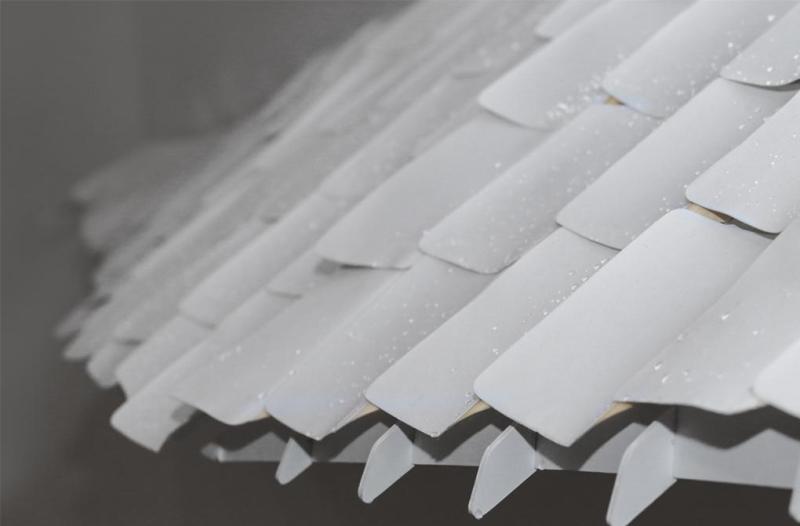Where [Isaac Newton] had his apple (maybe), [Chao Chen] found inspiration in a pine cone for a design project that lead to a water-sensitive building material. He noticed the way some pine cones are sensitive to water, closing up tight when it rains, but opening up with dry conditions. Some dissection of a pine cone revealed [Mother Nature’s] solution – different layers that swell preferentially when exposed to moisture, similar to how a bimetallic strip flexes when heated. [Chao Chen’s] solution appears to use balsa wood and a polystyrene sheet laminated to a fabric backing to achieve the same movement – the wood swells when wet and pulls the laminate flat, but curls up when dry.
 As [Chao] points out, the material is only a prototype, but it looks like a winner down the road. The possibilities for an adaptive material like this are endless. [Chao] imagines a picnic pavilion with a roof that snaps shut when it rains, and has built a working model. What about window shutters that let air and light in but close up automatically in that sudden summer storm? Self-deploying armor for your next epic Super Soaker battle? Maybe there are more serious applications that would help solve some of the big problems with water management that the world faces.
As [Chao] points out, the material is only a prototype, but it looks like a winner down the road. The possibilities for an adaptive material like this are endless. [Chao] imagines a picnic pavilion with a roof that snaps shut when it rains, and has built a working model. What about window shutters that let air and light in but close up automatically in that sudden summer storm? Self-deploying armor for your next epic Super Soaker battle? Maybe there are more serious applications that would help solve some of the big problems with water management that the world faces.
Make sure you check out the video after the break, with a more decorative application that starts out looking like an [M.C. Escher] print but ends up completely different.
















This is really neat, The idea is really cool, the thing i worry about though is some sort of mold or mildew forming on the wood due to it being exposed.
“What about window shutters that let air and light in but close up automatically in that sudden summer storm?”
Perhaps you are thinking of louvres windows? https://www.google.co.uk/search?q=louvre+window
Some are manual, some are automatic (especially heat-sensitive greenhouse windows), some are motorised. It would be easy to use different sensors to open/close them based on different conditions.
this would be drastically different though since it would be a passive feat of the material and not an active sensor.
it would also allow for a lot of creative uses besides the common ones of providing shade and shelter that adapts on its own.
Greenhouse louvres use expanding wax to open/close windows, similar to radiator theromostatic valves. No “active” sensor involved.
If you are thinking of shade, replace horizontal glass louvre with opaque/tinted material, and/or rotate a traditional vertical louvre curtain such as https://www.google.co.uk/search?q=louvre+curtain
didnt know they had that offering, which in principle is similar to the above, not exactly alike though, they are still composed of individual sensor and material so to speak, but i see your point.
i was specifically thinking beyond shade with that comment, photochromic glass will solve that issue, no movement at all required.
it could be used as self opening flood drains or a host of other practical applications, once they develop the material further that is, balsa wood and poystyrene wont hold much.
I can think of so many ways this could fail if ever put into service as a roof. The last thing anyone actually wants is a roof that isn’t actually water tight.
I understand your concern, but Hooray for your optimism when being introduced to the very first prototype of a new and potentially great technlogy! Was Charles H. Duell your grandpa?
Do you honestly think this is the first “active roof” prototype the world has ever seen? My lack of enthusiasm for this comes from 15 years working in building maintenance. I’ve spent enough time repairing roofing to know that this will not work out well.
That is just an indication that you don’t fantasize… I agree that normal roofs should be watertight (and that if they aren’t it will lead to a lot of problem) but balcony or patio could use something like this…
All these conditions are showcased in interior conditions. The materials look rather thin in order to react to the minimal amount of water necessary to cause the reaction. I would be curious to see how this holds up in a light breeze no less a gale storm.
Yes it seems to be a very fragile mechanism.
testing image posting
as to roofing, am I the only who know what a cedar shake is? they reacted quite well to rain for a “few” years